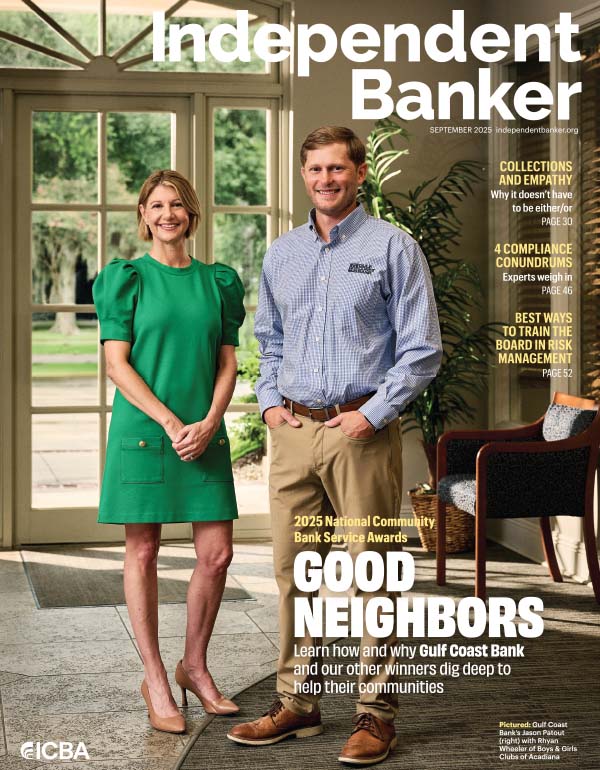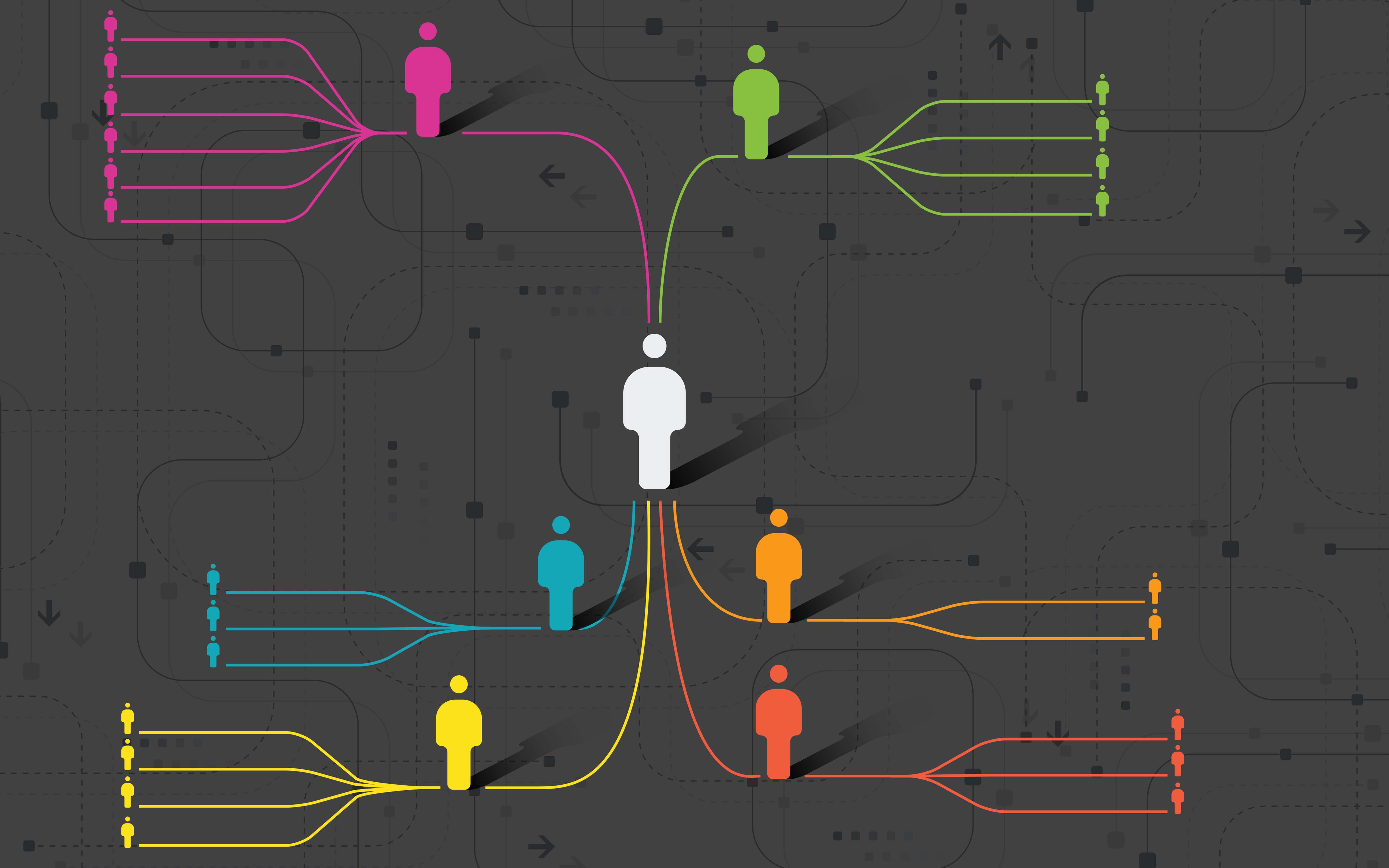In a landscape of increased competition, mergers and acquisitions, and new technologies, many community bankers believe that reorganization—whether company-wide or in specific areas of operations—is vital to success.
“We want community banks to survive and thrive,” says Clayton Legear, president and CEO of $740 million-asset Merchants & Marine Bank in Pascagoula, Miss. “It’s imperative to design companies and organizations the right way so that community banks can keep running.”
These five community banks tell us how rethinking their org charts has made all the difference.
Reevaluation following acquisition
Efficiency is a key motivator for an org chart reevaluation. OakStar Bank in Springfield, Mo., has moved to centralize internal support services to accommodate both its organic growth and several acquisitions.
In 2022, $2.7 billion-asset OakStar brought its acquired banks under a single charter. “When we started bringing new organizations together, some of the skill sets were repetitive,” explains the community bank’s president, Jimmy Stilley. “We looked at whether we could support the institutions that we bring in with our current policies and procedures.”
Tompkins Community Bank in Ithaca, N.Y., faced a similar problem to OakStar. The $8 billion-asset community bank recently consolidated four community bank charters into one. “We wanted to be more efficient in leveraging talent across our team,” says Stacie Mastin, senior VP and director of HR.
The two community banks took two similar but distinct approaches to their dilemmas. At OakStar, executives went directly to their teams for feedback, asking if and where they were having difficulty navigating the organization and if that difficulty stemmed from communication or policies.
After these conversations, OakStar decided to stand up a shared services department for the entire bank. “We’ve got skill sets and capacities throughout the bank,” says Stilley. “One market has a specialty that another market doesn’t. Where do we share and not share resources?”
OakStar mapped out the new organization layer by layer, surveying each position for specific tasks and percentage of time allocated to a task. Branch managers, for example, mapped out the tasks of universal bankers.
The community bank compiled the data into a spreadsheet showing where there were resources, synergies and gaps. “The data told us where we needed to get a lot more organized,” says Stilley. “Instead of everybody doing this in every market, we can make sure we have enough resources in shared services to support the bank as a whole.”
Tompkins Community Bank, on the other hand, centralized internal support services into what the bank calls Centers of Excellence. “Instead of four managers managing the same function, we have reorganized into one manager across four markets,” says Mastin, adding that four small business lending departments in four markets, each with their own manager, could result in four different strategies.
“By consolidating and taking people who are natural leaders in that space and giving them oversight across four markets, it has helped to drive our strategy in small business lending,” she says. “We’re leveraging talent better than we were before.”
The outcome for OakStar, Stilley reports, has also been tremendous. “The big thing is that it has produced capacity,” he says. “We had people that could take on more, but we weren’t organized enough to know what to have them take on.”
How Merchants & Marine helps employees grow
If your community bank is reorganizing, it’s imperative to help employees navigate the organization and chart potential career paths.
“As a baseline, community banks need to provide clear organizational structure and clear criteria for promotions,” says Valerie Utsey, ICBA’s EVP and chief people officer. “The transparency piece means a lot. If people can see the information themselves, it helps them make self-determinations about whether they’re meeting the criteria.”
Merchants & Marine in Pascagoula, Miss., offers self-paced promotions for frontline employees, giving employees considerable leverage over their own advancement. A level-one retail banker, for example, can complete assignments over a couple of years, demonstrate proficiency to a retail bank manager and promote herself. “We really want motivated people,” says Clayton Legear, the bank’s president and CEO.
Merchants & Marine Bank also has a job posting board that lists positions across its family of brands. “People are moving from division to division,” Legear says. “People who want growth opportunities can grow within a division, but we also make employees aware of every single opening. They can move and stay within the culture.”
Keeping the customer at the center
Customer experience is as much a goal of reorganization as is efficiency, and new positions and delegations have helped Origin Bank in Ruston, La., prioritize it. Lance Hall, president and CEO, emphasizes that customer focus has dictated the approximately $10 billion-asset bank’s structure.
Each of Origin Bank’s varied geographical markets—from urban areas of Dallas, Fort Worth and Houston to north Louisiana, south Alabama, Florida and Mississippi—has a market president to lead local operations and keep a pulse on the community. “Empowered, intelligent people close to the customer create a better experience,” says Hall.
The community bank also recently created the role of chief experience officer. “We work in an industry that is super commoditized,” says Ryan Kilpatrick, EVP and chief brand and communications officer. “To compete, we [focus on how we can] be more responsive, deliver faster [and] make customers feel a certain way.’”
The chief experience officer works as an internal consultant within the bank. “[He] is the customer champion inside the organization,” says Kilpatrick. “He’s finding ways that he can break down the silos that he finds.”
Ingrained culture in each department
Tompkins Community Bank has worked to embed cultural and development roles within each department. Mastin explains that the bank completely restructured its HR department, dividing it into one side led by a culture manager and another led by a manager of data and analytics.
While there’s a lot of buzz around new, culture-building titles such as chief culture officer, many banks, like Tompkins and Origin, are opting to embed these responsibilities as widely as they can in the organization.
“It’s a great testament to the vision and practice of Origin that today we don’t have the position of director of culture strategies,” says Kilpatrick, who previously held that title at Origin. “It permeates through the company, and there is ownership through the departments as to what the culture is.”
Hall emphasizes that Origin’s focus on culture is central to the bank’s business strategy. “Culture is a differentiator when it’s connected to strategy,” he says. “We said, ‘How do we create a culture that’s so strong that it attracts banking teams to us, so we can grow organically?’”
Origin maintains a culture council that meets quarterly through teleconference calls. The council is made up of employees from different markets and with different roles. “It’s important to get a broad range of employees,” says Hall.
Similarly, in January 2024, Tompkins Community Bank created three employee experience teams—each consisting of three people—assigned to commercial banking, shared services, and wealth management and insurance. “It’s been a great success,” Mastin confirms. “The employee experience teams have been able to hone their understanding of that one area of their business. They’re much more prepared to answer and coach managers and understand the unique challenges and development needs of that employee base.”
Meanwhile, the HR operations and data analytics team at Tompkins has created a dashboard that helps managers make personnel decisions. “This makes sure that the same filters are applied across the different lines of business,” Mastin explains. “We’re using a consistent lens to evaluate and assess employees. It provides a much better line into performance metrics.”
Managing six companies under one umbrella
Merchants & Marine Bancorp, the holding company of Merchants & Marine Bank in Pascagoula, Miss., unites six financial services firms, including a mortgage company and a firm that provides compliance and legal banking services to medical cannabis industries. “We’re a family of brands,” says Clayton Legear, the community bank’s president and CEO.
Beginning in 2020, the company reorganized under a single bank charter with independently operating divisions. Each of the companies has its own executive leadership team with full profit and loss responsibility and significant autonomy.
One of the divisions, Community of Resources (COR), centralizes operational support for the other divisions. “We bundled all nonclient-facing functions under the COR banner,” Legear explains.
He believes this structure has produced efficiencies that support the bank’s mission. “We don’t have the existential questions of, ‘Do we get large and sacrifice what made us community banks, or do we stay small and sacrifice our long-term financial independence?’”
Legear adds that divisional autonomy has sparked better performance. “The interplay between our CEOs is fascinating,” he observes. “They collaborate and challenge each other.”
Merchants & Marine has created some specific practices to ensure ongoing collaboration across its family of brands. The divisions take turns hosting quarterly after‑hours mixers for executives and front-line team members to get acquainted and learn how other companies operate. Merchants & Marine also schedules quarterly leadership exchanges in which top executives share high-level overviews of their businesses.
In addition, “brand ambassadors” for each company meet monthly with “brand advocates” from the holding company executive team to discuss strategy and performance. “It gives our holding company more insight, and they’re not just waiting on monthly reports,” notes Legear.
More tech, more job opportunities
New technology—and the additional titles that come with it—can also spur a company-wide org chart evaluation. EagleBank, an $11 billion-asset bank in Bethesda, Md., added digital banking to its repertoire, prompting a comprehensive organizational assessment.
“We looked at our business across the organization and studied how we go to market, what will be the role of customer care and how do we ensure that employees are trained to respond,” says Karen Buck, EVP and chief administrative officer.
And then, there was the introduction of new tech-related titles. “Ten years ago, there were no data scientists in any bank,” Buck points out. “Now lots of banks have a data scientist.”
Origin Bank has even added a robotics and intelligence process automation analyst. “We want to improve the customer experience and create efficiencies,” says Kilpatrick.
These new titles are just the tip of the iceberg. Increasingly, more decisions are becoming data-driven decisions. “Technology changes everyone’s role as they look at data to support decision-making,” says Valerie Utsey, ICBA’s EVP and chief people officer. “Risk management roles are expanding to address technological vulnerabilities resulting in increased fraud. Similarly, marketing roles are evolving to encompass the entire digital landscape.”
According to Utsey, implementing new technology must go hand-in-hand with clearly defined roles and responsibilities. “AI could span multiple departments,” she says. “Make roles clear and overcommunicate what the new role’s objective is and its impact to the broader organization, and, most of all, benefits to the customer.”
Speak up about changes
As they restructure, community bankers recognize the importance of employee engagement and communication throughout the organization.
“At the end of the day, we want our people to want to come to work,” says OakStar’s Stilley. “For the past several years, we’ve focused on culture. We want to create an environment where we serve one another and have a good time.”
Stilley has found that it’s crucial for employees to understand the bank’s larger goals and strategies. OakStar holds regular meetings at a variety of levels, both in-person and through a virtual event platform.
“We have begun going through a five-year strategic plan. We’re telling the team why we’re trying to achieve these goals,” he says. “We find that the team is better prepared and more engaged when we do a better job of providing the why behind what we are doing and where we’re going.”
Tompkins Community Bank: Cross-pollinating talent
Tompkins Community Bank in Ithaca, N.Y., has created a 24-month program for a small cohort of employees to explore different areas of the bank. The group rotates through departments for 18 months and then spends six months on a capstone project.
“It helps them identify what career opportunities are of interest to them,” says Stacie Mastin, senior VP and director of HR. “We’re making plans to intentionally move people along.”
Tompkins is also creating a career services center. This center will offer hands-on consultation for employees and self-guided solutions. It’s still in development, but the center will likely include predictive index behavior style assessments and job target comparisons, individual development action plans, curricula to develop skills and competencies, and access to internal career coaches, Mastin says.






